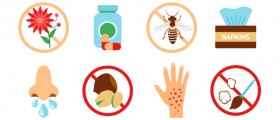
If you are suffering from an inflammation of the skin, it is possible that you are suffering from contact dermatitis. This is a localized rash or irritation that is usually caused by the affected area coming into contact with a harmful foreign substance. Some things that can trigger contact dermatitis include poison ivy, some foods and metals, cleaning solutions, cosmetics, detergents, chemicals, rubber, and perfumes.
Symptoms
It is often difficult to differentiate allergic contact dermatitis from irritant contact dermatitis. The former does not normally spread outside the area where contact with the trigger occurred. Irritant contact dermatitis often spreads relatively widely on the skin. The normal reaction is a red rash that appears immediately after irritant contact. Blistering of the skin might also occur, as might hives. With this condition, there will generally be itching and perhaps burning of the skin. Irritant contact dermatitis can be painful. The same condition can also affect the hands, which might be contaminated by dipping or resting in a container containing the irritant.
Causes
Two variations of the condition exist; irritant and allergic. The latter involves a negative reaction to a substance from the body’s immune system. The immune system triggers a negative reaction to the substance, normally an animal or vegetable protein. The system activates itself in order to produce antibodies to fight against the allergen. This is known as a hypersensitivity reaction. The antibody involved is called immunoglobin E or IgE. Upon contact with the allergen, the antibodies trigger a release of hormones and chemicals known as mediators. These mediators are what cause the symptoms of the allergic reaction. Initial exposure might not lead to a rash, but the skin will have become sensitized - this means that a rash will occur the next time contact is made with the offending allergen. Common allergens in the plant world that cause this type of allergic reaction include poison oak, poison ivy and poison sumac. There are many other substances that can lead to an allergic reaction. For example, hair dye, nickel, tanning agents for leather, rubber, and citrus fruit. Fragrances and medications might also cause a reaction.
The irritant variation results, obviously, from contact with a harmful or offensive substance. The severity of the reaction will worsen the longer that the harmful substance is in contact with the skin. Chemicals and household cleaners are common causes of this type of reaction. Those who suffer from other skin conditions are more prone to these types of reactions.

















Your thoughts on this
Loading...